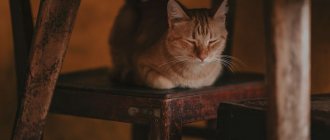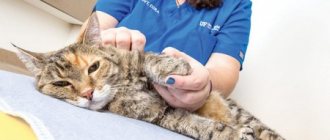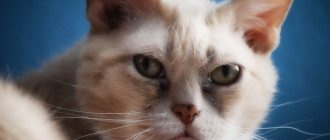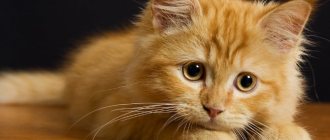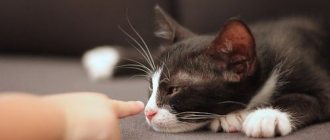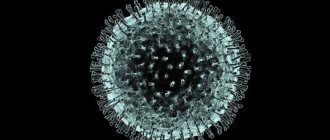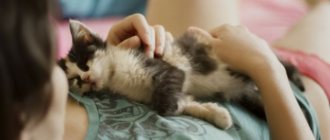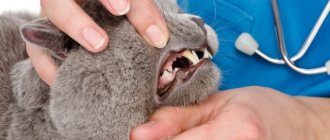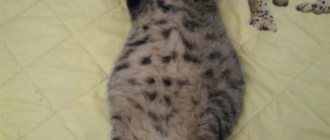A change in the color of visible mucous membranes is called anemia in veterinary and human medicine. During the development of the pathological process, the number of red blood cells and iron-containing protein decreases in the bloodstream. Anemia is not an independent disease - it is a kind of signal from the body, indicating the development of disorders in the functioning of certain systems.
Iron-containing protein, hemoglobin, is vital for the body, since thanks to it, oxygen is delivered to the tissue structures of the body. A cat suffering from advanced forms of anemia exhibits pronounced signs of hypoxia.
Normal color of mucous membranes in cats
Red blood cells are erythrocytes produced in the body in the bone marrow area. Subsequently, they penetrate into the systemic bloodstream, where they remain for about 120 days. As soon as red blood cells begin to age and become damaged, they are removed, and new blood cells begin to be produced from their remains. During the life of an animal's body, the number of red blood cells decreases due to a sharp loss of blood or as a result of their reduced production by the bone marrow.
A characteristic manifestation of anemia in animals is a change in the shade of visible mucous membranes. Under normal conditions, cats' gums are pink. With the development of anemia, the mucous membranes acquire a pale pink and sometimes white tint. The animal becomes lethargic and less resilient. If the cat owner has noted the whitishness of visible mucous membranes, lips and increased fatigue in the pet, it is necessary to contact a veterinary clinic for help and advice.
Signs that your cat has a fungus on his nose
We often complain that it is difficult with animals because they do not understand us. But just imagine how difficult it is for them with us... How difficult it is sometimes for them to convey to us that they don’t want to go to the litter box not because they don’t want to, but because they have problems with the litter - it smells bad or it hurts their paws. Or that this particular food smells strange, so you can’t eat it. Or maybe your health is poor: weakness, a tingling sensation in your side or a stinging sensation in your nose... It can be difficult to pay attention to the difference in behavior. Well, the baby sleeps longer, well, he refused lunch (he used to be capricious before). Or he meows and asks for something. It’s also not immediately clear whether he’s bored or sick.
The cat in question could either be mischievous or run amok out of boredom. If it were not for the stain, it would be very difficult to detect the problem. In addition, during stormy races around the room, he could hit or knock over something. Therefore, when he once raised his nose with such a “decoration” (see photo above), the first thought was that he had been hit and scratched. Then he began to be capricious, refusing to eat, and often meowing questioningly. I repeat, he could be picky and loud before. But because of the spot, we noticed that the meowing (and behavior in general) was more demanding.
The total signs were:
- The appearance of a spot on the nose that resembles a crust from a “sore.” Upon inspection, part of the crust fell off, but no scratch was found underneath.
- Nervous behavior aimed at attracting attention.
Causes of paleness in cats
One of the main formed elements of blood, red blood cells, are a depot for storing and transporting iron-containing protein. The average lifespan of red blood cells is about 3 months.
Hemoglobin, in turn, is represented by a complex protein compound that can bind to oxygen in the lung structures using an iron atom, subsequently delivering it to the cellular structures of the body. Without the participation of oxygen, not a single biochemical process occurs in the body of warm-blooded animals. In this regard, a sharp drop in red blood cells in the blood leads to disruptions in the functioning of all body systems.
The production of red blood cells, like other formed elements of blood, occurs in the structures of the bone marrow. There is a constant formation of elements and their subsequent destruction. The spleen is a hematopoietic organ responsible for the breakdown and disposal of spent red blood cells.
There are several factors that provoke the development of anemia in cats. Conventionally, the reasons are divided into several groups. Among them the main ones are:
- problems in blood formation processes;
- violation of factors contributing to the destruction of used red blood cells;
- problems in the balance of destruction and formation of new cellular structures of the bloodstream;
- malfunctions in the genetic apparatus.
Factors influencing the development of anemia indirectly affect the type of pathology. There are the following types of anemia in cats:
- posthemorrhagic type;
- caused by hemolytic processes;
- aplastic and hypoplastic;
- nutritional anemia.
The first type of anemia, posthemorrhagic, occurs in two forms - acute and chronic. The reason for the development of this type of pathology is external and internal hemorrhages. As bleeding develops, the number of red blood cells, and therefore hemoglobin, decreases. In the chronic form, there is a sluggish course of anemia associated with prolonged and regular loss of blood as a result of dysfunction of the liver and kidneys, bladder or other internal organs.
Posthemorrhagic anemia often develops against the background of severe infestation in the body. Parasites, in the course of their life activity, damage the integrity of the mucous membranes, causing minor but regular internal bleeding. The bone marrow does not have time to produce the required number of red blood cells, which results in anemia.
The second type of anemia is hemolytic, which develops as a result of the destruction of blood cells and with a further decrease in the amount of hemoglobin. Accompanied by hemolytic jaundice. It can be acquired or congenital. The acquired form of hemolytic anemia develops as a result of damage to red blood cells by toxins, blood parasitic organisms, viruses or poisons that penetrate the digestive system. Congenital anemia is caused by a genetic disorder, in which the formed elements of the blood cannot perform their functions normally. Taking medications such as Aspirin, which thins the blood, can provoke the development of hemolytic anemia.
An infectious disease, hemobartonellosis, can provoke hemolytic anemia. The source of infection is the bites of blood-sucking insects. Together with salivary secretions, parasites enter the bloodstream. Hemobartenella have the ability to attach to red blood cells, causing their destruction. The disease often occurs in a latent form and is called feline infectious anemia.
There is also a hypoplastic type of anemia associated with impaired formation of red blood cells due to problems in the functioning of the bone marrow or as a result of a lack of building components for the formation of red blood cells. Factors that provoke the development of hypoplastic anemia in cats are a lack of important microelements - iron, copper, cobalt, as well as protein components and B vitamins.
The most common form of anemia found in domestic cats is nutritional. The cause of disturbances in the body is a violation of the regime and rules of feeding the pet. Against the background of dietary disturbances, there is a decrease in the number of red blood cells in the bloodstream, accompanied by a decrease in the amount of iron-containing protein. The basic factor is an acute lack of iron in the diet, as well as problems with normal absorption with concomitant pathologies - inflammation of the digestive tract.
The clinical picture of anemia depends on the reasons that triggered the onset of the pathological process. There are also a number of common symptoms. The main ones are:
- change in the shade of visible mucous membranes - the mucous membranes of the mouth and eyelids acquire a bluish color (under normal conditions, the mucous membranes are bright pink);
- problems in normal cardiac activity - the heartbeat quickens, causing the development of shortness of breath;
- apathy and depression, rapid fatigue of the cat (the animal does not want to be active, preferring to lie down more);
- loss of appetite or complete refusal to feed;
- problems in the digestion process, growth retardation (kittens do not gain weight well).
In the case of the development of anemia against the background of large blood loss, the above symptoms are added - weakening of the pulse, decreased blood pressure, shallow breathing, and dilated pupils. It is possible to determine the presence of anemia in an animal at home, but without determining the underlying factors, it is not possible to prescribe adequate therapy.
Symptoms of dehydration
If a cat is in normal health and has free access to water, it maintains its own water balance. Signs of 6-7% dehydration become noticeable, the first of which is a pale nose.
Associated symptoms :
- discolored, dry gums;
- sticky saliva;
- sunken eyes;
- loss of skin elasticity.
Fluid loss of 10-12% has irreversible health consequences, and above 15% leads to the death of the cat.
When feeding dry food and little or no water in the bowl, the body may become dehydrated.
In other cases, dehydration occurs due to infection, poisoning, or traumatic damage to internal organs.
© shutterstock
The acute form of feline distemper (panleukopenia) is accompanied by severe thirst and vomiting, but the cat does not drink water. White plaque on a cat’s nose is one of the symptoms of this highly contagious infectious disease.
High temperature causes increased sweating and is accompanied by thirst. The cat has warm paws, ears, a white nose, and lies curled up in a ball.
Poisoning is accompanied by vomiting and diarrhea, which cannot always be noticed in time. Dehydration occurs quickly and requires urgent action.
Internal hematomas and bleeding due to falls from a height or fights cause severe weakness. Impaired blood supply to tissues leads to dehydration. Usually cats cannot drink and eat on their own due to severe weakness.
Diagnosis of possible diseases
Diagnostic measures include an integrated approach. Suspecting the development of anemia in a cat, the doctor takes into account the clinical manifestations and also prescribes a number of laboratory tests. An obligatory point of diagnosis is the collection of anamnesis.
A blood test is performed to determine the processes occurring in the bloodstream, as well as to determine the possible development of inflammation. If a bone marrow dysfunction is suspected, a bone marrow puncture is prescribed. Based on the data obtained, the veterinarian prescribes therapy.
Why did a domestic cat become infected with a fungus?
A domestic cat can become infected not only from other animals, but also from street clothes and shoes. The main character of this story really liked to sniff the owner's things after the street. He loved to lie on the threshold, smell shoes and bags... In general, he managed to collect all sorts of microscopic nonsense.
But this does not mean that you should shy away at the sight of street animals. Some kind of infection will still get on things one way or another. You walk on the ground, not fly through the air. It’s just that even absolutely domestic animals need to be vaccinated as well, and also shown to a veterinarian if they show signs of poor health. Not to mention those that have access to the street.
What should a healthy cat's nose look like?
A healthy cat's nose is moist, cool and slightly slippery. The cat regularly licks it, and it is covered with a special secretion that creates a protective mucous membrane. For a cat, the nose is not just an organ of smell. With its help, she determines the direction of the wind, the temperature of an object, and even touches it with her nose along with the vibrissae. Constant moisture on the surface of the nose increases its sensitivity, while a dry nose cracks, causes discomfort and cannot cope with its functions.
A very young kitten has a dry nose because it does not yet know how to lick itself, and the moisturizing secretion is not yet released due to age.
When is a dry nose a sign of illness?
A dry nose in itself is not a sign of illness. If it is dry and hot, and the ears are also hot, then we can talk about an increase in the cat’s body temperature. The temperature of cats and other animals is measured rectally by carefully inserting the thermometer 1 cm into the anus and holding it there for about a minute.
The normal temperature for a cat is 38-39 degrees, for bare-haired breeds the norm is 39-40. In kittens and pregnant cats, the norm shifts up 0.5 degrees. An increase of one degree is not critical, but a higher temperature requires urgent consultation with a veterinary specialist.
If you can’t see a doctor right now, you can wait a few hours. During these hours, the cat periodically needs to apply an ice pack to the head or under the chin, and drink warm water from a syringe without a needle. A hairless cat can be wiped with a damp towel, and a fluffy cat can be sprayed with water from a spray bottle.
Important! You cannot lower your cat’s temperature with aspirin, paracetamol, nimesulide and other drugs from the human first aid kit. This is deadly for animals.
You should immediately consult a doctor if your cat has a dry and hot nose, and at the same time the following are noted:
- convulsions;
- cough;
- sneezing;
- prolonged vomiting;
- diarrhea;
- difficulty urinating;
- drops of blood in urine or stool;
- constipation;
- temperature rise of more than two degrees;
- loss of consciousness;
- unnaturally long sleep;
- foaming at the mouth or excessive salivation;
- copious discharge from the eyes, genital loop (not to be confused with estrus in females), anus;
- screaming for no apparent reason;
- unsteady gait;
- hair loss or matting;
- skin rashes;
- difficulty or wheezing breathing.
Infectious diseases
Fungal infections. Cats sometimes suffer from cryptococcal nasal infections. They are caused by fungi present in the environment and occur in both indoor and outdoor cats. Fungal infections can be accompanied by severe inflammation and destruction of nasal structures.
The diagnostic method is to determine the titer of antibodies in the blood, which increases during infection; cytological examination of the nasal mucosa; PCR diagnostic method. The preferred treatment is the use of internal antifungal drugs (their type depends on whether the brain is affected).
Side effects of internal antifungals include vomiting, diarrhea, decreased appetite, and liver problems. Often a course of treatment lasting 3–12 months or even longer is required.
Bacterial infections – Primary bacterial infections, which are the main cause of nasal problems, are very rare in cats. However, often bacteria, taking advantage of the fact that the tissues of the nasal cavity are damaged by the disease, cause secondary infections that accompany damage to the nasal cavity for any other reason. Because of these secondary bacterial infections, cats often improve when antibiotics are given, but when the antibiotics are stopped or simply over time, the symptoms worsen again because the underlying cause is not addressed. Because cats normally harbor bacteria in their nasal cavity, culture of deep tissue samples is necessary to diagnose a bacterial infection.
Mycoplasma infections (mycoplasmas) are a special type of bacteria. These microorganisms can infect any part of the respiratory system, including the nasal cavity. Diagnosis of mycoplasma infection requires cultivation under special conditions. Unfortunately, mycoplasmas grow very poorly in culture, so a negative microbiological culture result does not exclude mycoplasma infection. Only certain types of antibiotics can kill mycoplasmas. These include: azithromycin (Zithromax), doxycycline and enrofloxacin (Baytril).
Tooth root abscess . Infection of the tooth root can lead to the formation of an abscess. Sometimes in such cases, the abscess ruptures into the nasal cavity, and not into the oral cavity or onto the surface of the skin. In some cases, we detect tooth root abscesses during clinical examination. It can be diagnosed by dental x-ray, CT scan or MRI. These abscesses often require dental surgery and antibiotics to treat.
Viral infections. These infections, including calcivirus and herpesvirus infections, may be accompanied by discharge from the eyes and nose, as well as ulceration of the oral mucosa. Cats often become infected with these viruses when they are still kittens, and symptoms return when stressed. Diagnosis can be made based on viral isolation. An L-lysine supplement can be used for treatment.
What to do if your cat has a dry nose?
If you discover that your cat's nose is not properly moistened, you need to observe the animal. If the cat is actively playing, eating well, and behaving as usual, then there is no reason to worry.
If her ears are hot, her nose is excessively dry or even peeling, you need to take her temperature. If the temperature rises by more than one degree, it is better to show the cat to the veterinarian. Even if by the time of the examination the temperature returns to normal by itself, you need to donate the cat’s blood for analysis. This will help identify hidden infections.
Important! You can’t lubricate your cat’s nose with anything, even if it has cracks or damage. She will lick it herself, and natural hydration will be restored after the symptoms of the disease are relieved and the animal’s condition is normalized.
A dry nose is not always a sign of disease or illness in a cat. But in combination with other alarming signs, you need to monitor the animal’s condition and, if necessary, contact a veterinarian. If you don’t self-medicate your pet and don’t hope that everything will go away on its own, it will delight its owner for many years.
